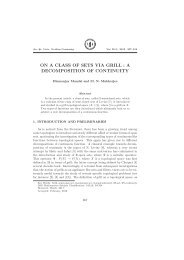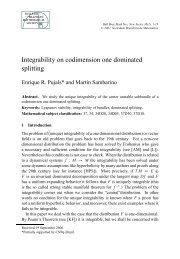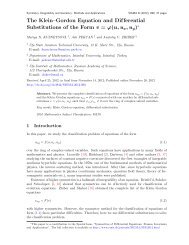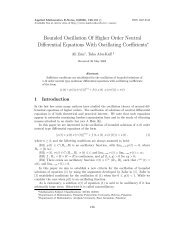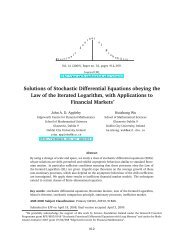ENRICHED INDEXED CATEGORIES Contents 1. Introduction
ENRICHED INDEXED CATEGORIES Contents 1. Introduction
ENRICHED INDEXED CATEGORIES Contents 1. Introduction
Create successful ePaper yourself
Turn your PDF publications into a flip-book with our unique Google optimized e-Paper software.
<strong>ENRICHED</strong> <strong>INDEXED</strong> <strong>CATEGORIES</strong> 6455.2. Lemma. Large V -categories form a 2-category V -CAT , which contains the 2-categoryV -Cat of small V -categories as the full sub-2-category of large V -categories with exactlyone object.Proof. Just like Theorem 3.17.The most obvious non-small example comes from V itself.5.3. Example. If V is closed as in Theorem 2.14(iii), then we can define a large V -category whose objects are the objects of ∫ V (that is, the disjoint union of the objects ofthe categories V X ) and whose hom-objects are the external ones V (x, y). (Recall fromRemark 2.19 that the external-homs can be defined in terms of the fiberwise ones forarbitrary V . This explicit definition suffices to make them into a large V -category.)5.4. Remark. When V has indexed coproducts preserved by ⊗, we have the “discreteV -category” 2-functorδ : S → V -Cat ↩→ V -CAT .As in Remarks 3.11 and 3.16, we can make sense of “V -functors f : δX → A ” and “V -natural transformations α : f → g” between them, even when V lacks indexed coproducts.Namely, the former is simply a choice of an object a ∈ A and a morphism ɛf a : X → ɛain S, while the latter is simply a morphism I X → A (a, b) in ∫ V lying over (ɛg b , ɛf a ). Inparticular, any large V -category A induces an S-indexed categoryV -CAT (δ−, A ) : S op → Cat.Again, in §7 we will identify this with a special case of “change of cosmos”.5.5. Definition. If κ is a regular cardinal, then we say a large V -category A is κ-smallif its collection of objects is a set of cardinality < κ. We say A is ∞-small or set-smallif its collection of objects is a small set (of any cardinality).Note that if S is a small ordinary category, then a V -category A is set-small if andonly if for each X ∈ S, there is a small set of objects of A having extent X.5.6. Remark. If we allow κ to be an “arity class” in the sense of [Shu12], then accordingto this definition the “small V -categories” of §3 may be called “{1}-small”.5.7. Remark. Recall from Example 2.30 that an S-indexed monoidal category V givesrise to a Fam(S)-indexed monoidal category Fam(V ). It is straightforward to identifyset-small V -categories, as defined above, with small Fam(V )-categories, as defined in §3.(Of course, by allowing “large families” we could include all large V -categories.)In particular, for a classical monoidal category V, we can identify set-small Const(⋆, V)-categories with small V-enriched categories in the classical sense—while we have alreadyobserved in Example 2.30 that Fam(V) = Fam(Const(⋆, V)), and in Example 3.2 thatsmall Fam(V)-categories (in the sense of §3) can also be identified with small V-enrichedcategories.



